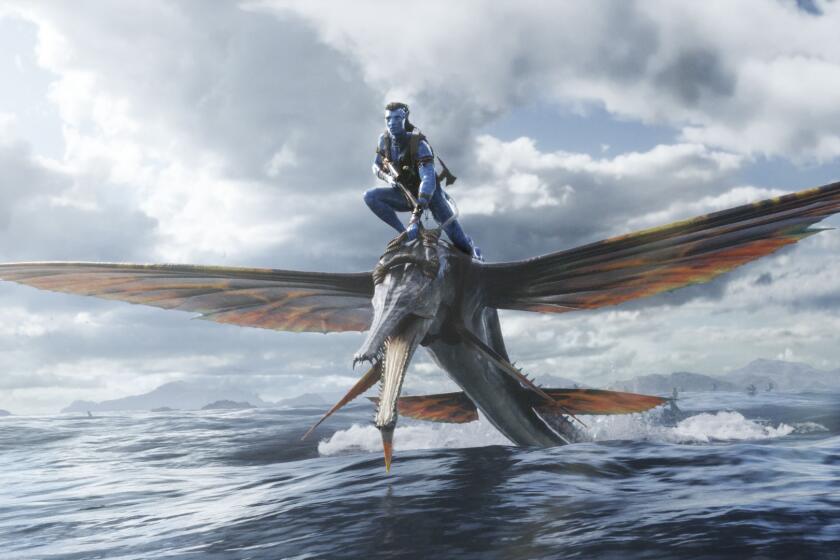13 years ago, ‘Avatar 2’ was impossible. Inside the groundbreaking plan to pull it off
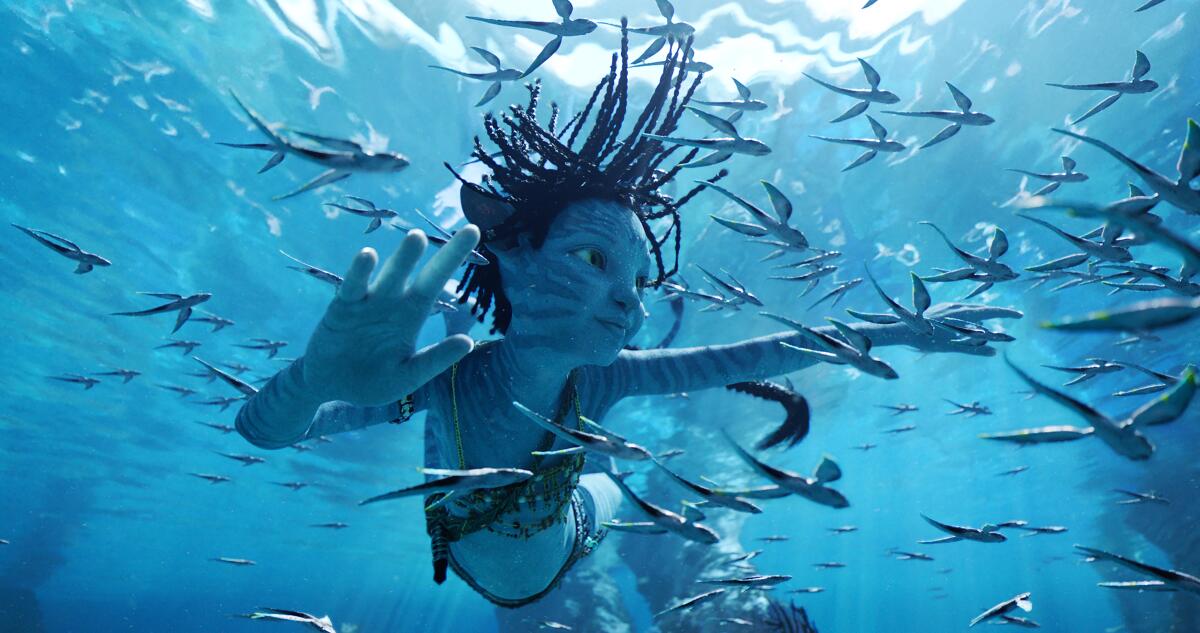
- Share via
In the long-awaited sea-quel “Avatar: The Way of Water,” now in theaters, James Cameron delivers on his promise to explore Pandora’s glittering oceans 13 years after the historic success of 2009’s hybrid live-action/motion-capture epic “Avatar.” But bringing the blockbuster follow-up to life required the Oscar-winning filmmaker, cinematographer Russell Carpenter and a team of actors, experts and technicians to achieve the “impossible” yet again.
Their biggest challenge? Hint: It covers 71% of Earth’s surface.
In 2013, Cameron, armed with thousands of pages of notes expanding the world of Pandora, decided on the aquatic setting and set a team of writers to pen the sequels. But Jon Landau, who has produced all of Cameron’s films since “Titanic,” immediately foresaw a problem: The technological processes used to capture actors playing Na’vi on dry sets did not yet exist for capturing them wet. “Right away we started doing R&D,” he said, “because no one had ever done performance capture underwater.”
The long-awaited James Cameron blockbuster is expected to gross $150 million to $175 million through Sunday, which would be a strong start.
Set years after the events of “Avatar” in a new corner of Pandora, “The Way of Water” finds ex-Marine Jake Sully (Sam Worthington), Omatikaya warrior Neytiri (Zoe Saldana) and their four children taking refuge with the seafaring Metkayina clan, with whom they must adapt to ocean life to survive. Characters swim, bond and battle beneath the surface for more than half the film, gliding astride sleek mounts on creatures called ilu and alongside the massive, whale-like tulkun.
They dive in and out of the ocean while racing at high speeds, commune and communicate while floating far beneath the surface and engage in harrowing action sequences — all of which the cast and stunt teams performed, outfitted with special wet suits and facial capture camera rigs, while free diving in the water.
Nearly a decade after its conception, Cameron’s sequel required innovation on par with the original: the development of a new, underwater cinematic vernacular, and the technology to capture it. Here’s how they pulled it off.
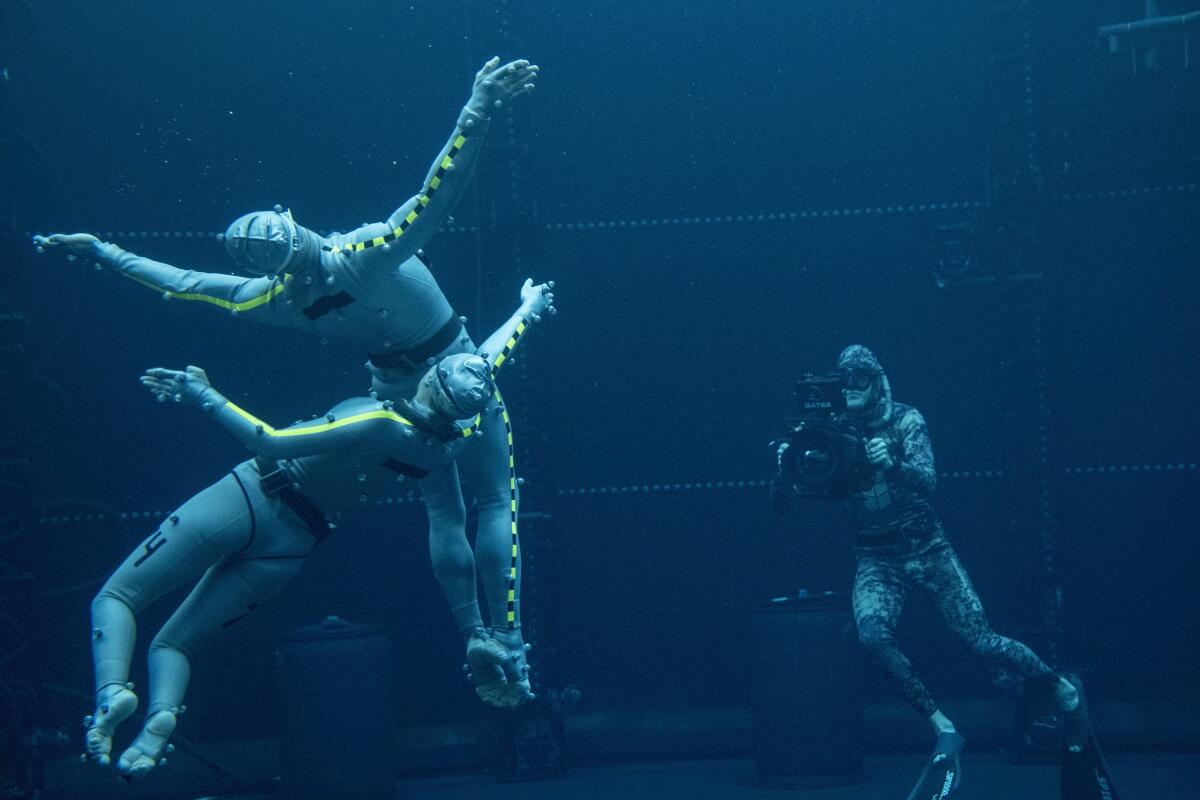
‘Our movies are big movies’
For virtual production supervisor Ryan Champney, the way into “The Way of Water” began in his bathtub.
Champney, whose credits include the Cameron- and Landau-produced “Alita: Battle Angel,” had worked on the first “Avatar’s” Simulcam system, which allowed Cameron to see computer-generated elements integrated into live action in real time, as well as the robotic eye-line technology that allows human actors to play opposite physical, pre-programmed representations of their 9-foot-tall Na’vi co-stars on set.
Coming aboard the sequels in 2012, Champney was part of a small team tasked with building on technology used in the first movie and translating it into a water setting without losing the nuances of an actor’s performance in the motion capture process.
“Most movies get greenlit, there’s a couple of months of prep and there are limits to what you can get done,” he said. “And I think Jim has this ability to be, like, we’ve got to do this — whether or not other people adopt this, let’s push things forward.”
At first, production experimented shooting dry for wet, with performers in motion capture suits rigged on wires in the air, approximating in-water movement. Needless to say, Cameron didn’t go for it. “We did A-B comparisons to show to Jim and said, ‘Can you tell the difference?’” Champney said. “He said, ‘I don’t need to. We’re going with the underwater solution.’ He didn’t even look at the test.”
Experiments at home, then in Landau’s swimming pool, established methods for waterproofing cameras in submersible housings. But the water itself presented new issues. “We quickly found out that the infrared gets absorbed in water, which is normally how we do motion capture, so we had to go to ultraviolet light ... that would transmit through water but would also be picked up by the camera sensor,” Champney said. “There wasn’t a lot of information out there on the topic, so it was a lot of trial and error.”
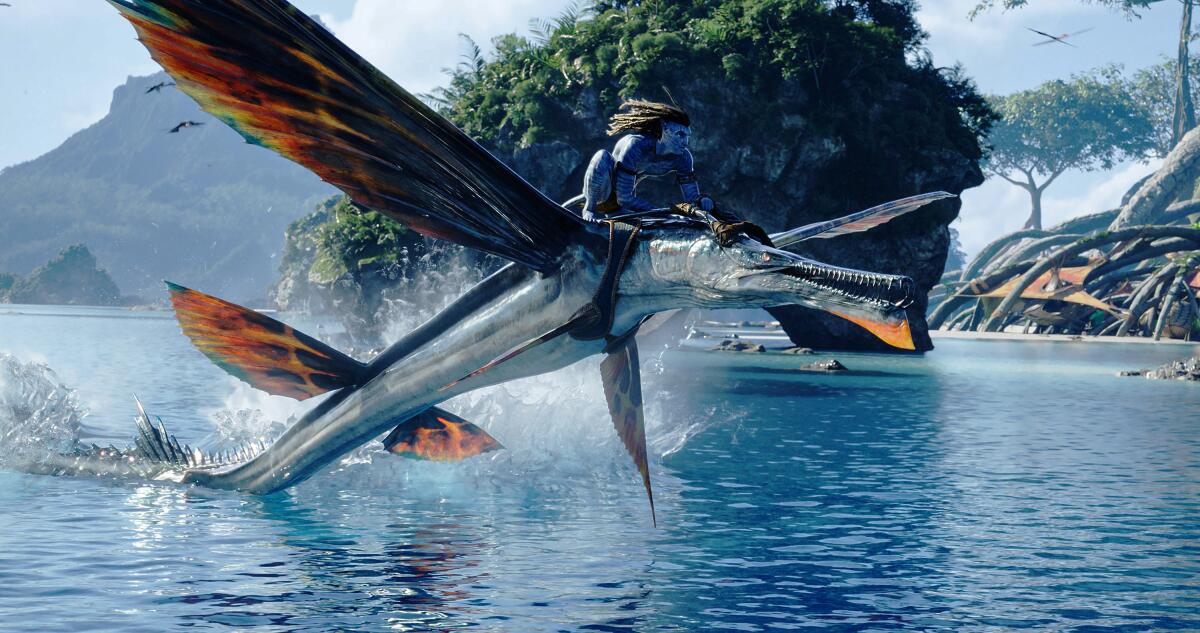
As methodologies clicked into place, tests graduated to bigger and bigger locations — a scuba training pool where a single figure could be captured in 3D; a large outdoor tank that could hold more performers.
In the process, said Landau, “we realized that the performance capture system that worked above the water wasn’t going to work under the water. We needed to create two different volumes, as we call it, but they had to work in sync with one another, because we need to be capturing someone jumping in above and capturing them below and making all those things work together.”
While Landau declined to reveal the cost of the research and development phase for the sequels — “The Way of Water” has an estimated budget of $350 million — he credits studio 20th Century Fox with meeting the production’s unique needs. (The first “Avatar” scored a lifetime gross of $2.92 billion, still the box-office champ of all time.)
“I learned a lesson on ‘Titanic’ where we didn’t push to get the R&D money enough for the sinking of the ship from different angles, and it caught us a little bit by surprise,” Landau said. “That lesson taught me that if you push for the R&D money now and you do it right, you’re going to end up with a much more efficient process.”
“Yes, our movies are big movies,” he said. “But I honestly believe that if you look back at the movies that we’ve done, at the end of the day for what is up on the screen, they were done as efficiently as anybody could possibly do them.”
Thirteen years after the first ‘Avatar,’ James Cameron finally returns to the distant moon of Pandora in this transporting, radiantly personal sequel.
‘Now work on the part that broke’
After the proof-of-concept stage, two massive tanks were engineered at Cameron and Landau’s Lightstorm Entertainment hub at Manhattan Beach Studios, one used for training and more intimate character scenes. The larger second tank — the “Swiss Army knife of water tanks,” measuring 120 feet long, 60 feet wide and 30 feet deep with a 250,000-gallon capacity — was outfitted with powerful wave and current machines, used to capture the film’s more action-packed sequences involving Na’vi characters.
Performance capture cameras were set up around the tanks’ perimeter along with safety cameras for monitoring those in the water. To control light reflection from above, the water’s surface was covered with small, white floating balls, inspired by an L.A. Times article Champney read about shade balls deployed in the Los Angeles Reservoir to reduce evaporation, and from a similar method Cameron used on his 1989 film “The Abyss.”
“Once we got it working, they started putting in vehicles and safety divers and waves and everything else. I was like, ‘OK, we didn’t test any of that.’ But we made it work!” Champney said. “That’s the good thing about Jim. He pushes it until it breaks and comes back a little bit, and then he says, ‘Now work on the part that broke.’”
To capture the underwater action with sufficient clarity, it was not possible for anyone in the tank to use scuba gear, because air bubbles might interfere with the accuracy of the sensors. So how could Cameron keep his cast in the water long enough to capture their performances?
The solution was both simpler and more complicated than the alternatives: Everyone — including new and returning actors like Worthington, Saldana, Sigourney Weaver and Kate Winslet, reference camera operators, grips, and the safety divers accompanying each actor — would have to work while holding their breath under water, requiring extensive training, additional safety procedures, and ample time.
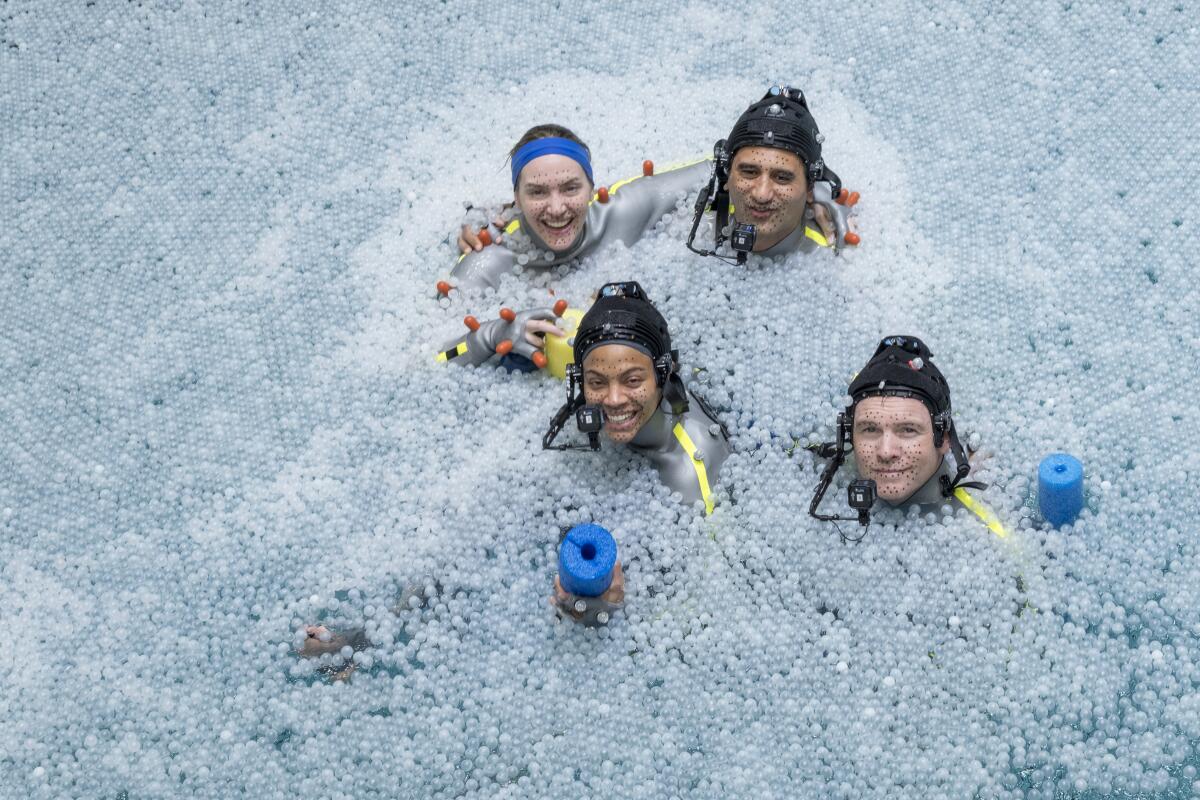
‘It’s the biggest diving movie of all time’
“This is unlike anything ever done before,” said Kirk Krack, the professional free diver and coach who trained actors, stunt performers and crew for months leading up to the “Avatar” shoot. “It’s the biggest diving movie of all time because it’s shot wet for wet — this isn’t Aquaman hanging on a wire with a fan in their hair. This isn’t some [VFX artist] programming what they think swimming looks like. ... There’s never been a movie that has done what this underwater unit did to the level we did it, to the realism of the reality we’ve done.”
A chance meeting on a shared flight years earlier had given Krack, a veteran free diver who worked on the 2009 documentary “The Cove,” the opportunity to introduce himself to Cameron. “I walked up and said, ‘Nothing ventured, nothing gained,’” Krack remembered with a smile. “My name’s Kirk. I’m a free diver, and I’m going to hand you my card and say, ‘How long can you hold your breath?‘”
It would be several years until Krack got the call, while free diving the shipwrecks of Truk Lagoon in Micronesia. Meeting with Krack in Los Angeles shortly thereafter, Cameron laid out his “Avatar” pickle.
“He tells me about the project, the different films, how [‘Avatar’] 2 is 60% water, 3 is 30%, 4 and 5 will be 15%,” Krack said. “How the new Na’vi of the ocean are called Metkayina, they’re free divers, and the problems they’ll have with capture because of the bubbles. They’re thinking of rebreathers instead of scuba systems, and do I think free diving could do it? I said, ‘Absolutely. And here’s how I would do it.’”
‘Avatar’ has been derided as the cinematic equivalent of a theme park. But that’s exactly why fans stuck around so long for sequel ‘The Way of Water.’
Krack’s solution was to teach cast and crew to hold their breath using technical free diving methods. This would mean augmenting breath holds with the use of enriched oxygen mixtures before or after a dive, to reduce risk of hypoxia and speed recovery.
Working with actors in the training tank, Krack helped get “Avatar’s” stars so comfortable in the water they no longer thought about the fact that they were diving. “You can’t be breath holding and free diving and trying to bring your character to life when you’re just becoming a breath holder yourself and you’re looking like your cheeks are [puffed out],” Krack said.
He and the actors considered how their characters would move relative to the ocean and their ease in it, and rehearsed scenes underwater to build an experiential base they could tap into during filming. An in-water workflow was established: Actors would turn on their own camera rigs for each take, go through a safety countdown, dive down and find their marks with Krack’s help, then perform their scenes.
“It was like a microcosm of a rocket launch,” Champney said. “‘Safety team go, reference cameras go, hydraulics go — is everyone good?’”
Between takes Cameron would give notes, which Krack would help translate using nonverbal cues, and they’d try to quickly reset. “He’s Michelangelo. Just, you know, painting with 1,500 people,” Krack said. “He is going to get it until it tells the story, the physics make sense, the movements make sense. Whereas most other directors or studios might just say, ‘Eh, close enough.’ And that’s what will make this the biggest movie of all time.”
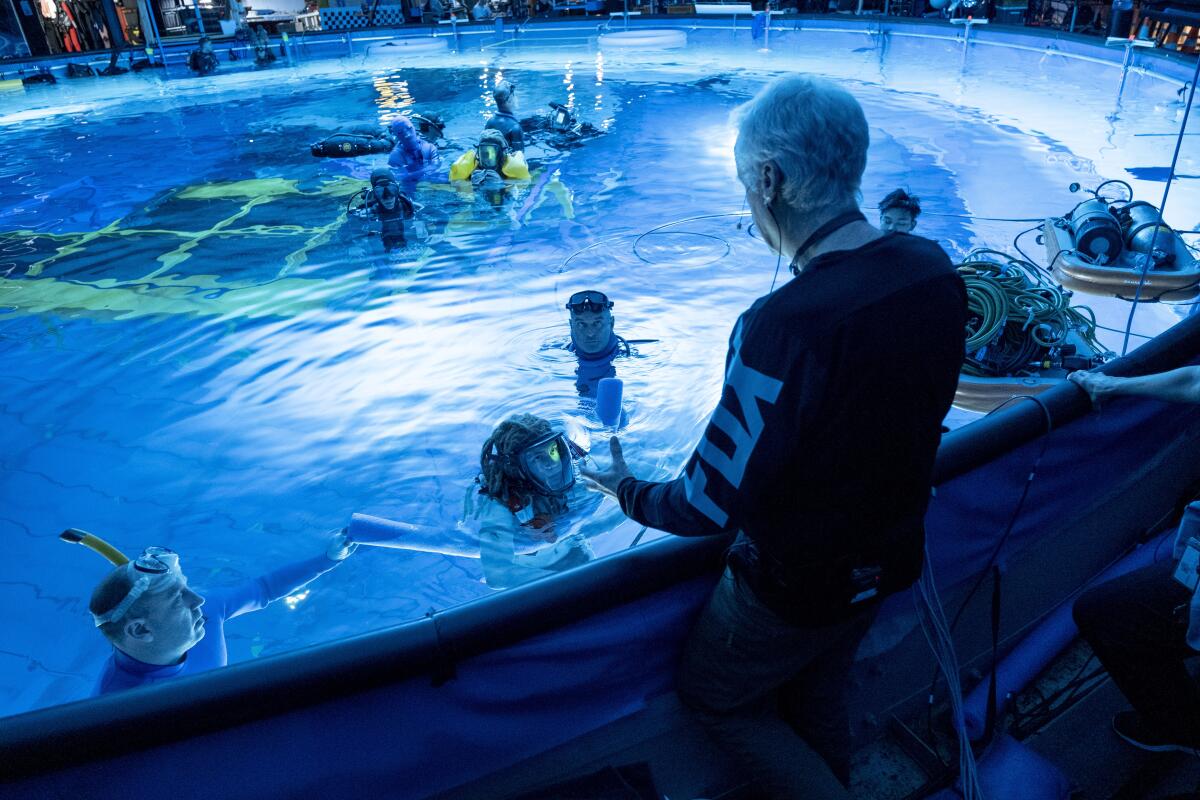
He’s Michelangelo. Just, you know, painting with 1,500 people.
— “Avatar: The Way of Water” free diving expert Kirk Krack
Over an 18-month performance capture shoot that began in 2017, Krack’s team, actors and crew logged more than 250,000 free dives. At its busiest, the tank set had 26 people underwater on breath hold with motorized water vehicles standing in for Pandoran sea creatures zooming around the space.
But one of Krack’s proudest moments was watching Weaver, who was 69 years old when she began free diving training, outlast a stunt diver on breath hold while performing a scene as her new Na’vi character Kiri, the teenager Jake and Neytiri have adopted into their family.
“It’s like holding your breath and running,” said Krack, who marveled as Weaver kept going for three minutes before heading back to the surface. “She was so immersed. She was her character. She did this massive breath hold on this huge active metabolic scene. I’m super proud, and that’s a testament to all the work she put in.”
Swimming, much less free diving without breathing apparatus or scuba tanks, didn’t come intuitively at first to actor Bailey Bass (“Interview With the Vampire”) before she was cast in the sequels as Tsireya, a Metkayina teen who calls the ocean home.
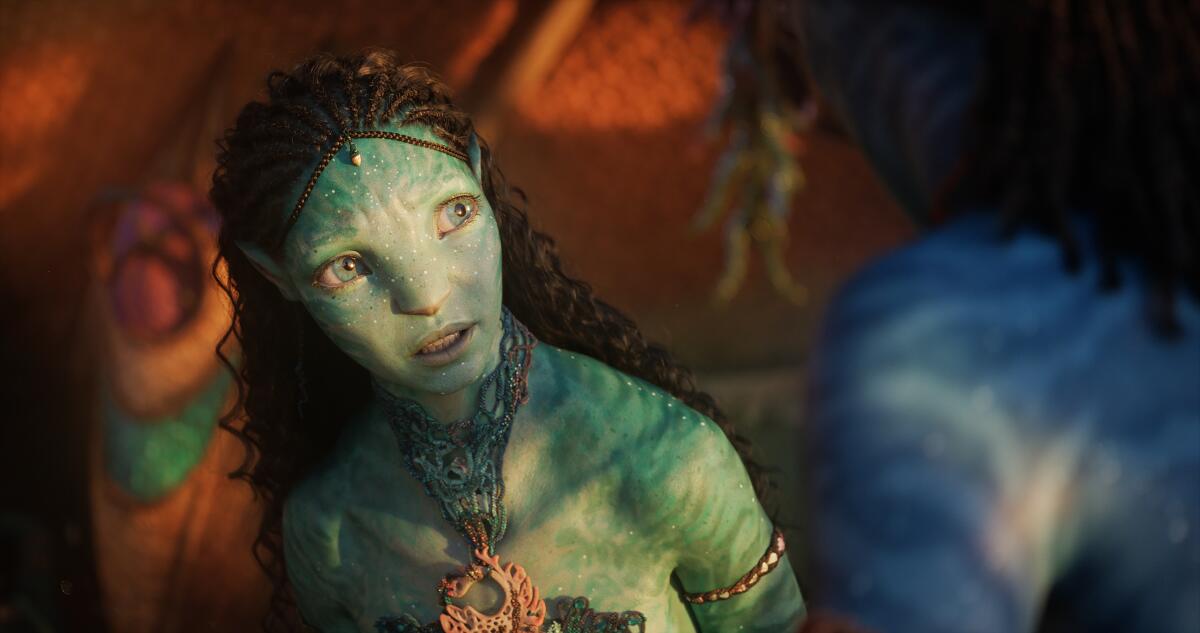
But for five months Bass, then 13, trained alongside her co-stars to breath hold for several minutes at a time. Given her character’s comfort in the water, she also underwent scuba certification in Hawaii before filming her role over the course of two years as one of the “next generation” Na’vi characters introduced in “The Way of Water.”
“It was about getting to a point where you can have a calm breath hold and really be comfortable underwater,” said Bailey, now 19, who also found that yoga practice helped. “Having the calmness of yoga allowed me to have longer breath holds and just chill out and meditate underwater.”
By the time back-to-back performance capture for the second, third and fourth films concluded, free diving had become second nature to the cast. “I was more comfortable underwater than I was running on land,” Bass said.
The average length of a dive for performance capture was 4 minutes, she said. To a non-diver, that might sound daunting. But Bass found it liberating. “When you’re underwater and you’re swimming and you’re there, just you and no sound, it’s so freeing,” she said. “I would love to do it again.”
More to Read
Only good movies
Get the Indie Focus newsletter, Mark Olsen's weekly guide to the world of cinema.
You may occasionally receive promotional content from the Los Angeles Times.

